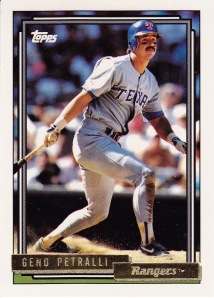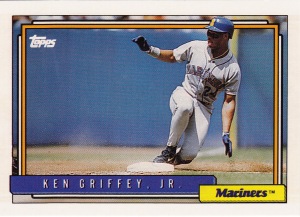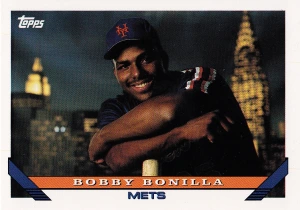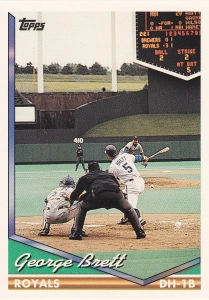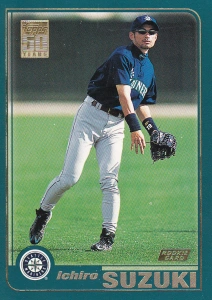1992 Topps
Card I selected: #40 – Cal Ripken
Another Hall of Famer for my pick in the 1992 set. This was my pick as the best card from the 1992 set – the Iron Man next to the monument for the Iron Horse. I feel like you could make the case that this is the best pure photo in Topps run of its base sets.
# of cards (including the Topps card): 5
The parallel sets in 1992 include:
- O-Pee-Chee
- Gold
- Gold Winner
- Micro
Scans:
1992 Topps #40
1992 O-Pee-Chee #40
After a long run, 1992 was the last version of O-Pee-Chee teaming up with Topps to make a Canadian parallel of the Topps set. O-Pee-Chee came out with its first set of its own in 1992 and they wouldn’t collaborate after that year. There were actually a few more distinctions between the sets than there had been the past couple of years. The main thing that was the same, however – there was no longer a difference in cardstock since Topps was now printing its cards on white stock paper.
Here are the differences for this card:
- There is an O-Pee-Chee logo on the front where the Topps logo is.
- There is an O-Pee-Chee logo on the back where the Topps logo is.
- The copyright on the bottom of the back says O-Pee-Chee and notes the card was printed in Canada.
- Any wording on the back is in both English and French.
- There is no watermark on the back (the 1992 Topps cards have a Topps logo as a watermark)
1992 Topps Gold #40
After discontinuing its “Tiffany” set after the 1991 season, Topps started doing a full parallel of the base set and inserting it into packs. Topps had what was a novel idea at the time – 1992 was the first time Topps, or any manufacturer, inserted a full parallel set in its packs. Topps Gold parallel cards had the player and team name at the printed in gold foil, and the watermark on the back said “Topps Gold” in gold color. The 6 checklists were replaced by 6 more players for Topps Gold.
Topps had some company with this idea; a “Black Gold” parallel was issued at a much more common 1 per pack in Leaf’s 1992 card set. The Topps Gold cards came 1 per box into its 1992 product. Topps also included 10 Gold cards into each regular factory set, and produced 12,000 factory sets of the Gold cards.
1992 Topps Gold Winners #40
This new idea wasn’t without a bit of a snafu. A 10-pack of Topps Gold Winners set was available by playing and winning the Topps Match-the-Stats game. The prize was originally going to be Topps Gold cards, but the game was compromised through some savvy use of a dark room and a flashlight (see here for the explanation). Topps honored the request, but added a “winner” stamp to the Gold foil for cards received as a prize for the game so the rarer Topps Gold cards weren’t devalued.
1992 Topps Micro #40
Topps also produced a “micro” set for the second time. These mini-cards were produced in factory set form, measuring 1″ x 1-3/8″. Other than the fact they are ridiculously small, they are the same as the main set.
The “Rainbow”:
Any sets I didn’t get: None that I can think of.
Other cards I would have liked to do: Ken Griffey Jr., who has a great horizontal card of him popping up after a slide into third. Also, Craig Wilson has a really cool card where he’s juggling (though it’s the 2nd straight year Topps did a card of him juggling).



































